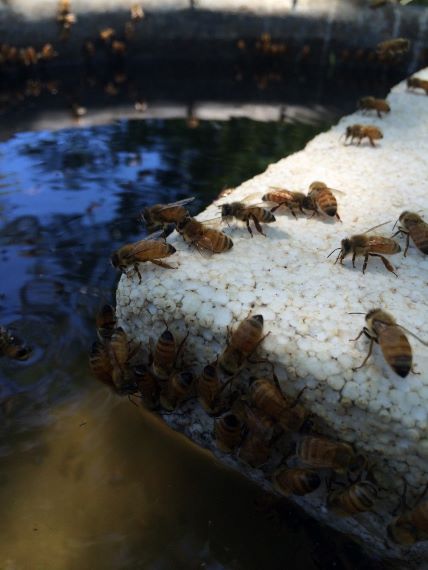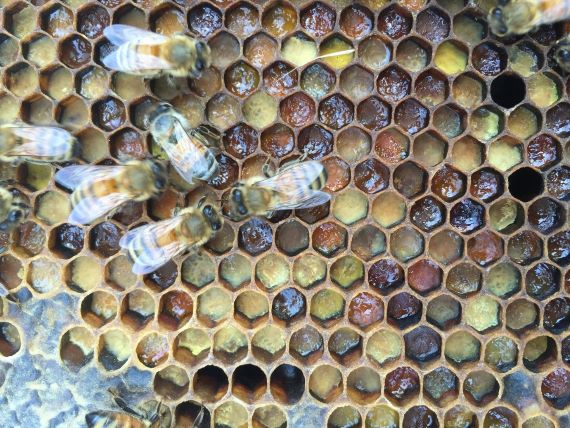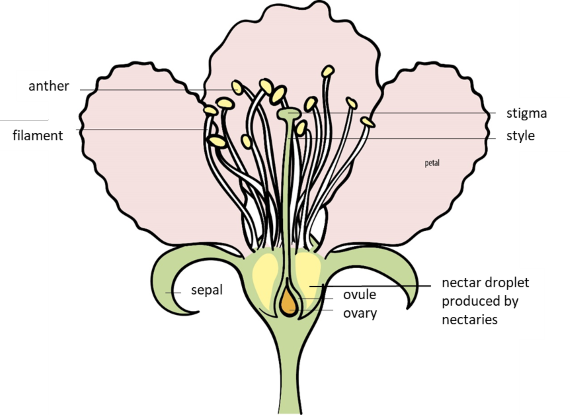
Nutritional requirements of honey bees


Honey bees require water, nectar and pollen to meet their nutritional requirements.
Water
Honey bees require water just like any other organism to meet their metabolic needs. Water from nectar (35-85% water content) is usually sufficient in meeting their needs. This however, is not the case when honey bees are relying on honey stores as their food source because honey bees use water to dilute the honey for consumption. Other than for consumption, water plays a crucial role in the temperature regulation of a colony especially once temperatures rise above 30 °C.
It is best to provide water as close to the hive as possible (within 200 m), and importantly do not let water containers run out of water. Providing a platform for bees to land on will help to stop bees from drowning (eg. sticks, floats, cloth).
Nectar
Nectar is secreted by glands at the base of the flowers, known as nectaries. Field bees collect nectar from blossom in the field. At this stage, the nectar has a high level of sucrose sugar with some fructose and glucose and a high moisture content, with traces of other substances such as minerals, vitamins, pigments, aromatic substances, organic acids and nitrogen compounds.
Nectar is the primary source of carbohydrates providing bees with energy for:
- Flight
- Heat production
- Wax production
Bees convert nectar into honey for storage in a series of steps. When the nectar is initially collected, it is stored in the honey sac of the returning field bee. An enzyme called invertase is added to the nectar while in the bee’s honey sac. Invertase converts the nectar, primarily a sucrose solution, to a mainly fructose and glucose solution. The ripening nectar is then stored in the beeswax cells where the moisture content is reduced to 13–18% by the manipulation and fanning of the house bees. When honey is ripe, bees cap the cells with beeswax.
The presence of stored honey or fresh nectar is essential for the colony’s survival. Without it, the colony will starve, as often happens in late winter and early spring. See bee products section for more detail on when to harvest honey and how much can be harvested at a time.
The presence of fresh nectar will stimulate the colony to expand its brood nest. The population in the hive will grow, which will ensure a strong hive capable of collecting even more nectar and converting it to honey. Strong hives are the essence of successful beekeeping.

Pollen
Pollen is the male reproductive element of flowering plants. While it provides genetic material and nutrients for the development of seed, it is also an important component of honey bee nutrition. Pollen is gathered by foraging field bees from the male parts of flowering plants called the anthers. When foraging on flowering plants bees become covered with pollen grains. This aids the transfer of pollen between flowers (cross-pollination). Although this is important for many plants to prosper, it is also an important ingredient in satisfying honey bee nutritional requirements.
Pollen is the primary source for protein (amino acids), fat/ lipids, minerals, vitamins and sterols and is essential for:
- Brood production
- The development of young adult bees (nurse bees feeding larvae and other colony members)
Bees store about 1kg of pollen as beebread near the brood nest. During storage pollen undergoes a fermentation process whereby bees add enzymes and nectar/ honey to the freshly collected pollen.
Brood rearing
Brood rearing activity in the colony influences the quantity of pollen collected by bees. The larger the brood area to be fed, the greater the demand for pollen. Queenless colonies continue to collect pollen, which is stored in the brood combs despite having no brood to nurture.
Colonies deprived of sufficient pollen - either in quality or quantity - will use their own body protein to feed larvae. Brood reared on poor quality pollen produces adult bees with reduced longevity and colonies deprived of pollen will eventually cease rearing brood.
Nutritional value of pollen
Pollens from different floral species can vary significantly in relation to protein (amino acids), lipids/ fats, mineral and vitamin content. For this reason, some pollen sources are considered of higher value than others in their contribution to honey bee nutrition.
As an example, pollen produced by pine trees is considered to be of low value in pollen quality with a protein level of around 7%. Belbowrie/broad-leaevd tea tree (Melaleuca quinquenervia) and some lupin and banksia species at 34% are excellent. Pollen needs to have a protein level of 20% to satisfy minimum honey bee dietary requirements. In addition, all other dietary requirements for amino acids, fat/lipids and minerals must be at desirable levels. What these desirable dietary levels are, is not yet fully understood.
The protein component of pollen is composed of a series of amino acids. DeGroot (1953) identified a number of amino acids that are essential for the normal growth and development of bees (see the table below).
Table 1: Essential amino acids to satisfy honey bee nutrition requirements (DeGroot 1953).
Amino acid | Bee requirements (g/16g N) |
|---|---|
Threonine | 3.0 |
Valine | 4.0 |
Methionine | 1.5 |
Isoleucine | 4.0 |
Leucine | 4.5 |
Phenylalanine | 1.5 |
Histidine | 1.5 |
Lysine Arginine Tryptophan | 3.0 3.0 1.0 |
Bees can compensate to some extent for pollen with lower than desirable levels of amino acids by consuming more pollen, and if the pollen have protein of high value, bees can excrete the surplus amino acids. With low value pollen bees cannot physically consume enough pollen to make up the requirements of what is considered as a desirable level of amino acids. Thus, both the quality and quantity of pollen collected by honey bees are equally important.
Honey bees often overcome any dietary deficiency in one pollen source by having access to multiple floral sources. Pollen collected concurrently from three or more floral sources will often balance out any deficiency experienced from one single source.
A strong productive colony may consume over 50kg of pollen per year when it is being manipulated and worked in an intensive manner.
For detailed information on the nectar and pollen quality of NSW and Eastern states flora as it relates to honey bee nutrition, see the publication Honey and Pollen Flora of South-Eastern Australia by Dr. Doug Somerville
Seasonality
The climate largely dictates the flowering frequency and extent of our diversified floral species. A bee colony will expand its brood area in early spring as the weather warms and the number of flowering plants yielding nectar and pollen increases. With an ever-increasing area of brood comes the increasing demand for nectar and particularly for pollen. Normally in spring there is an abundance of available pollen. Pollen may be abundant at some other times of the year, depending on the characteristics of the flora in various regions.
REFERENCES
Crane, Eva (1975). Honey — a comprehensive survey. International Bee Research Association.
DeGroot (1953). ‘Protein and amino acid requirements of the honey bee’, in Physiol. Comparata et Oecolog.
Kleinschmidt, GS (1986). Research papers, QAC. Laws, Qld.
Seeley, T. D. (1995). The Wisdom of the Hive: The Social Physiology of Honey Bee Colonies. Cambridge, MA: Harvard University Press .

